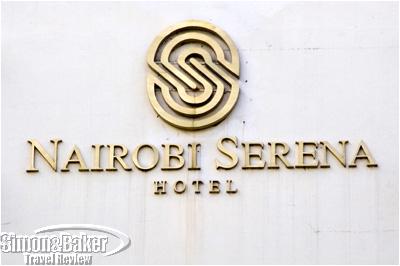
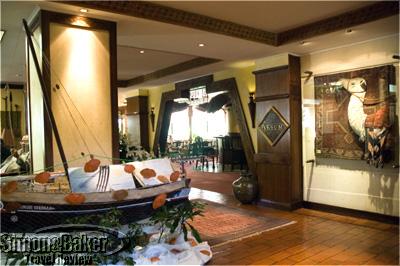

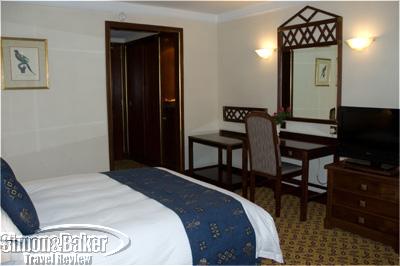
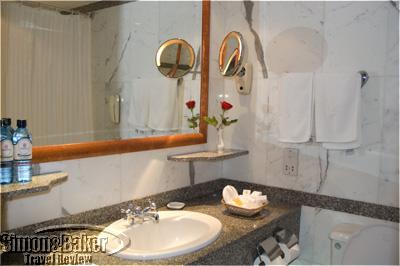
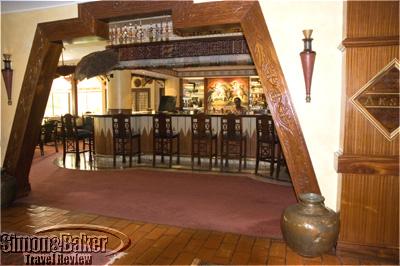

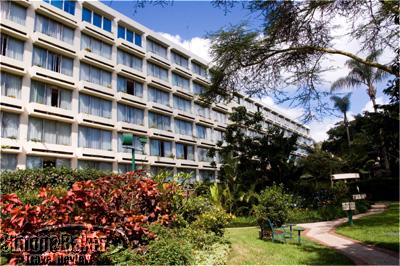

Within the gated world of the Serena, the atmosphere had the sophisticated elegance and attentive hospitality of luxury hotels worldwide, coupled with a unique décor that blended Moroccan and Swahili influences with tribal antiques and contemporary African art. While the property was unmistakably urban, and its several lounges and restaurants seemed to be favorite meeting spots for the local political elite as well as the cosmopolitan business community, it seemed equally welcoming to tourists. I had felt a brief pang of self-consciousness, walking into the smart lobby in hiking boots still dull with the dust of the Masai Mara game reserve I had left only a few hours before; until the bellman who took charge of my well-travelled duffle bag casually inquired how I had enjoyed my safari. The polished Nairobi Serena staff were no strangers to rumpled safari travelers.
My room was a quiet, air-conditioned haven overlooking gardens filled with palm, bougainvillea and jacaranda trees and the glittering towers of the downtown Nairobi skyline beyond. The public spaces were equally inviting. A crystalline swimming pool the size of a small lake was surrounded with tiled terraces filled with umbrella-shaded lounging and seating areas. Servers were standing by to deliver a cool drink or a light meal at a moment’s notice. The restaurants featured a variety of cuisine options, with prompt seating and friendly service. The boutique was exceptionally well stocked with gifts and casual clothing at prices comparable to that of downtown stores. There never seemed to be a compelling reason to venture out the serene world of the Serena, until it was time for me to reluctantly head for the airport. The Nairobi Serena definitely made my list of hotels to revisit and recommend whenever traveling to Kenya and East Africa.
Concierge The concierge desk was staffed around the clock with several well informed and helpful attendants.
Connectivity In-room and common area WiFi Internet access was available for a daily fee 1,000 Kenyan shillings (13 U.S. dollars).
General Manager Mark Gathuri
Handicapped Access Most public areas allowed for handicapped access. All guest rooms were accessible via elevator. Some rooms were specially designed to be wheelchair friendly.
Length Of Stay Two nights
Location A five-minute walk from the city center and Central Park in Nairobi, Kenya. Jomo Kenyata International Airport was 12 miles (20 kilometers) away, a 30 to 60-minute drive depending on the time of day.
Owned-Managed Tourism Promotion Services (TPS Serena); The Aga Khan Fund for Economic Development (AKFED) was the majority shareholder.
Restaurants In addition to The Mandhari, the less formal Café Maghreb provided excellent all-day dining including daytime à-la-carte service and sumptuous breakfast and evening buffets. Light snacks were available at the Pool Bar and afternoon tea in Bambara, a lounge open exclusively to hotel residents. The Aksum bar served cocktails and beverages only. The hotel offered 24-hour room service with an extensive menu and prompt service.
Size The six-story structure featured 183 rooms and seven suites.
Year Open-Renovate The hotel opened in 1976. It was entirely renovated in 2006
Room My 215 square foot (20 square meter) standard room, Number 310, was decorated in a pan-African style in shades of taupe and bright blue, with mahogany furniture and woodwork. There was a queen-size bed with ornate wooden headboard, two bedside tables topped with brass, and wall-hung reading lamps. There were also two barrel chairs upholstered in striated dark blue velvet. They sat in front of the picture window on either side of a square end table. Windows had sheer white curtains, with bright blue and taupe draw-drapes framed by a taupe valance and side panels. A three-drawer bureau served as a base for the television set. A writing desk with a high-back chair held a desk lamp. A tall mirror and prints of African birds in gilded frames hung on the pale taupe walls. The crisp, bright white high-count cotton sheets and duvet cover were accented by a blue bed scarf and toss pillows. In addition to the usual hanging closet, the room featured a built-in mini-bar under a marble countertop, topped by shelving that held a coffee service and a variety of glasses.
Facilities There was an outdoor swimming pool, a spa, hair salon and fitness center, a boutique/gift shop and a sundries store, a full service business center and a conference facility.
Gift Shop Hazina (Swahili for treasure) was an appropriate name for the gift boutique. It offered a wealth of high quality local handicrafts, traditional gifts, carvings, ethnic jewelry and casual fashion at fair prices.
Pool The larger than Olympic-size outdoor heated swimming pool was the main focal point of the gardens. It was surrounded by the palm-shaded Pool Bar, the terrace of Café Maghreb and an expansive lounging area with two rows of rattan chaises with bright green cushions, shaded by market umbrellas. Towels were available from a kiosk at the far corner of the pool.
Spa The Maisha Spa featured a range of skin therapy and massage treatments, separate women and men steam rooms, saunas and Jacuzzis, a gym and aerobics/yoga studio, juice bar and relaxation area.
Date Of Review November 2008
Reviewers Article and photographs by Josette King
Service Front desk staff were efficient and business-like. Restaurant staff were attentive, warm and friendly. My room was serviced twice a day
Would You Stay There Again? Yes